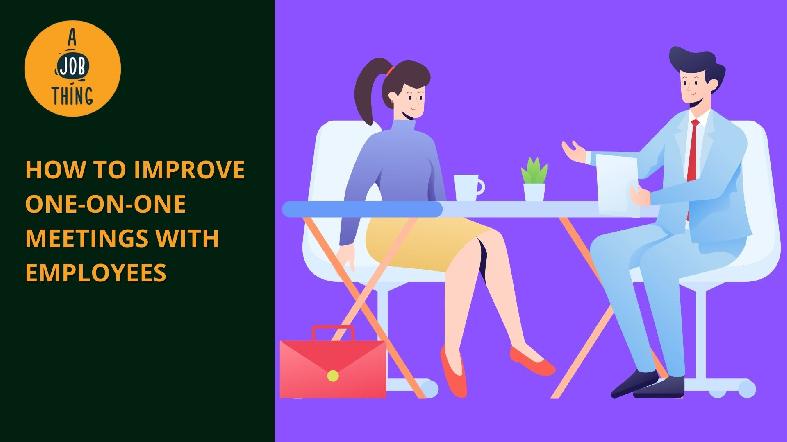
How to Improve Your One-On-One Meetings With Employees
Create Job Description Using AI
Write appealing job descriptions for any job opening to attract the most qualifield and suitable candidates. FOR FREE.
try now
Direct reports' one-on-one meetings are frequently more rushed and disorderly than they need to be. It's critical to regularly check in with each of your staff, but how can you make the most of your time?
How can you improve the efficiency and collaboration of your meetings? What are the things you need to change as a manager, and what are the things you need to ask your direct reports to do differently?
Why one-on-one meetings are vital for your organisation
We tend to connect with direct reports via email, instant messaging, phone, and text in the digital age. But, nothing surpasses a face-to-face, one-on-one meeting. As a manager, one-on-ones are one of your most critical productivity tools.
They're where you can ask strategic questions like, "Are we concentrating on the correct things?" They're also how you show employees that you value and care for them from a rapport standpoint."
Conducting an effective one-on-one meeting takes considerable cognitive agility. Your goal is to demonstrate your dedication to assisting your colleague in developing and growing, as well as to take a step back, remember the organisational mandate, and consider how best you can work side-by-side with this person to get things done.
Here are some suggestions for making the most of these meetings:
Regularly schedule the meetings.
The frequency of one-on-ones depends on:
-
The size of your team,
-
The size of your organisation,
-
How high-maintenance or experienced your employees are, and
-
Where you happen to sit in the organisation chart.
It doesn't matter how frequently they happen; what matters is that you plan them on your calendar as a repeating event.
Employees will be less inclined to bombard you with a continuous stream of disruptions if they know they have a meeting scheduled. Experiment with different frequencies until you discover the ideal one. A few more logistical considerations:
-
First and foremost, arrive on time. It's frustrating for your employee if you arrive 10 minutes late to a 20-minute meeting.
-
Two, don't leave it until the last minute to cancel. That sends the polar opposite of the message you're attempting to send.
Make a list of discussion topics.
In an ideal environment, you and your colleague would collaborate on an agenda ahead of time. Workplace stress and time limits, on the other hand, frequently get the best of us. A more practical goal could be to make a list of bullet topics you'd like to cover.
Request that your direct reports do the same. When you're face to face, compare lists and conduct some loose timeboxing to ensure you have enough time to cover the most important points. You need to establish an incentive to focus and set expectations around what's most important. You should bring the meeting back on course if it gets off track.
However, flexibility is also important. In other words, some structure is required, but not too much. These meetings are best held when you and your employee are in "co-creative mode." Decide together what you'll be able to do in the time you've been given: Are there any items that can be discussed for a later date?
Being fully present is essential.
Shift gears and get out of autopilot when it's time for the one-on-one. Consider the encounter a valuable time of connection, rather than just another item on your to-do list. Think to yourself, "I'm here to make a difference in this person's life." Give your employee your whole attention.
Turn off your phone and silence your computer to avoid being distracted by pings or rings. It's so simple to unwittingly send a message that you don't care about the other person and that whatever's on your phone is more important.
Begin with an optimistic attitude.
Start the meeting by sharing a win. You could, for example, congratulate a colleague on a presentation she presented. Say something like, "I know you worked really hard on this, and I believe it turned out great." It's an excellent technique to begin a one-on-one conversation since it generates pleasant energy.
Solve the issue
One-on-one sessions are ideal for delving into significant strategic issues and solving problems.
It's critical to find a balance between asking questions and listening to what your colleague has to say.
Remember that you are there to learn. Some managers urge staff to create a template to identify their problems and possible remedies before their meetings. This compels the employee to go through the problem-solving process ahead of time. As the manager, you can then provide constructive criticism.
Ask about career plans.
While critical issues and those of strategic importance should take precedence, don't overlook the personal ones. One-on-ones can be a great way to encourage your team members to think more deeply about their jobs and personal lives.
You have to see your colleague as a whole person. Ask questions. Some managers want to talk about professional growth at every meeting, while others like to do it at every other. It's up to you, but if you plan to discuss career ambitions, give your employee advance notice because such discussions demand reflection and thought.
Before you bring up the matter, give employees time and space to consider what they want to say. When you're face to face, ask direct but open-ended questions regarding the goals of your report. It's an excellent way to keep folks motivated and on track.
Thank them.
Close the meeting the same way you started it: with optimism.
End on a tone of praise and thankfulness. Employees value words of affirmation. A simple thank you would suffice.
Don't say something if it isn't genuine or feels authentic, but if you can talk about something they're doing well or say something like, 'I appreciate and value what you're doing,' it's powerful.
Remember the following principles.
Do:
-
Start each meeting by sharing a win. It generates a positive vibe.
-
If you plan to discuss professional growth with your employee, let them know ahead of time because those discussions need thought and consideration.
-
Keep an open mind. Listen to your staff's issues and offer suggestions for how they might resolve them.
Don't:
-
Cancel. Arrive on time to show your employee that they are important to you.
-
Be rigid. While it is crucial to have a plan, it is also necessary to be flexible.
-
Please don't forget to say "thank you." It's critical to demonstrate your respect for your colleague.
Source: Harvard Business Review





